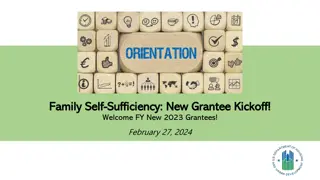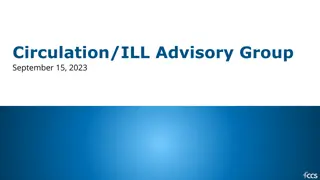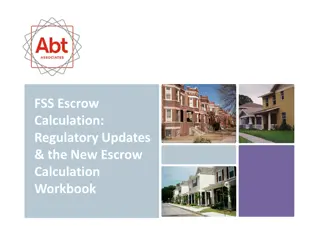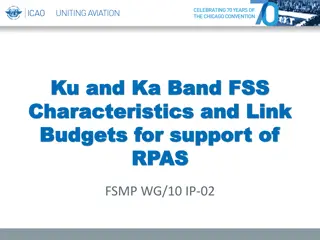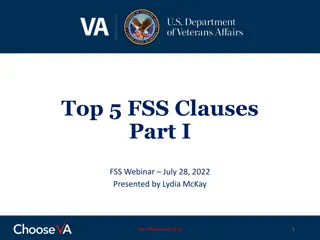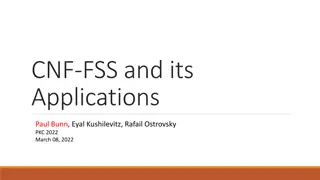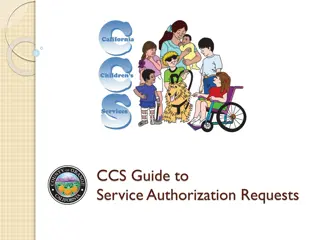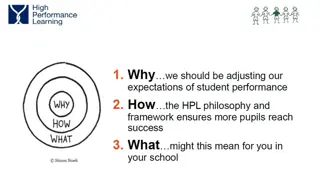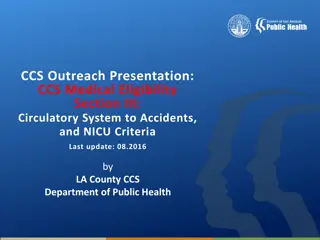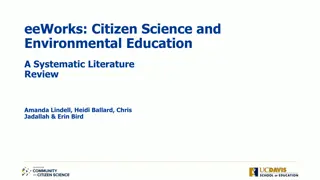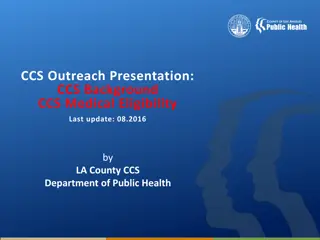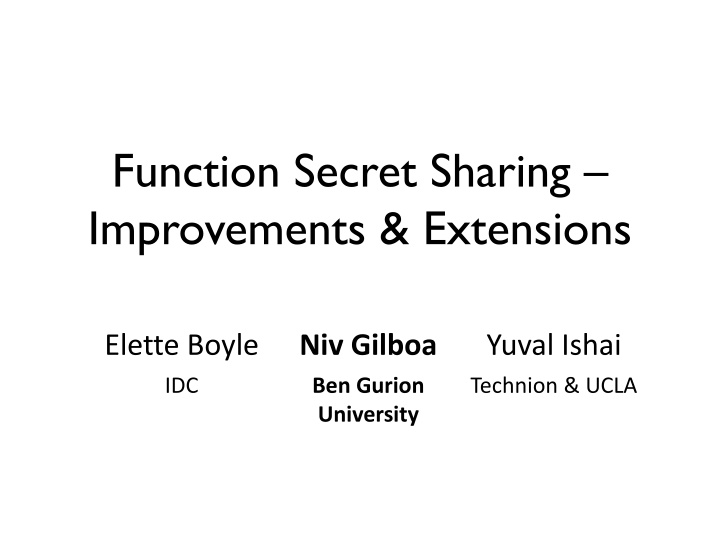
Advanced Techniques in Function Secret Sharing for Secure Applications
Explore innovative advancements in function secret sharing methodologies such as additive secret sharing elements, efficient reconstructions, and known cryptographic protocols like OWFs, DDH, and LWE. Discover practical implementations in private keyword search applications and improved distributed point functions for enhanced security in data sharing.
Download Presentation

Please find below an Image/Link to download the presentation.
The content on the website is provided AS IS for your information and personal use only. It may not be sold, licensed, or shared on other websites without obtaining consent from the author. If you encounter any issues during the download, it is possible that the publisher has removed the file from their server.
You are allowed to download the files provided on this website for personal or commercial use, subject to the condition that they are used lawfully. All files are the property of their respective owners.
The content on the website is provided AS IS for your information and personal use only. It may not be sold, licensed, or shared on other websites without obtaining consent from the author.
E N D
Presentation Transcript
Function Secret Sharing Improvements & Extensions Elette Boyle Niv Gilboa Yuval Ishai IDC Ben Gurion University Technion & UCLA
Additive Secret Sharing Elements in Abelian group G s0 + s = s s1 Secrecy: si hides s Reconstruction: s0 + s1 = s (in G)
Function Secret Sharing [BGI15] f0 f0(x) + f = f(x) f1(x) f1 Secrecy: fi hides f :{0,1}n G in a class F Reconstruction: f0(x) + f1(x) = f(x) Efficiency: |fi| ~ |f| Distant cousins functional secret sharing [BBDK00], [KZ16]
What is Known? One-Way Functions (OWF) Point functions [GI14, BGI15] F={fa,b: fa,b(a)=b, for x a fa,b(x)=0} Intervals [BGI15] F={fa,b: fa,b(x)=1 iff a x b} Decisional Diffie-Hellman (DDH) Any F computable in log-space [BGI16] Learning With Errors (LWE) Any Function (relaxed notion [BGI15], full notion [DHRW16])
Contributions All results from OWF Practical applications! Improved Distributed Point functions (DPF) Verifiable FSS Secure against malicious clients FSS for decision trees Generalization and simplification via tensor approach
Application: Private Keyword Search [CGN97, FIPR05, OS05, OG10, ] Name Phone The biased media must not know about this Paris Hilton 212-555-**** Temple Taggart 323-555-**** Server 0 Alice Machado 213-555-**** Jessica Leeds 312-555-**** Name Phone Paris Hilton 212-555-**** Server 1 Temple Taggart 323-555-**** Alice Machado 213-555-**** Jessica Leeds 312-555-****
Application: Private Keyword Search [CGN97, FIPR05, OS05, OG10, ] Server 0 y0= if0(namei) phonei y0 fAlice,1:{0,1}n {0,1} Name Phone f0, f1 Paris Hilton 212-555-**** Temple Taggart 323-555-**** f0 Alice Machado 213-555-**** Jessica Leeds 312-555-**** f1 Name Phone Paris Hilton 212-555-**** y0+y1=1 phoneAlice Temple Taggart 323-555-**** Alice Machado 213-555-**** y1 Jessica Leeds 312-555-**** y1= if1(namei) phonei Server 1
Application: Anonymous Messaging Riposte [CBM15] Whistleblower drop-off m Server 0 Server 1 f0 f1 Anonymously post m
Application: Anonymous Messaging m m m Server 0 Server 1 f0 f1 Anonymously post m Client Client Anonymously post m Client Client Handle collisions via coding
Improved Distributed Point Function
Results Functions f:{0,1}n G, PRG:{0,1} {0,1}2 Comparison with [BGI15] Key (Query) length n Improved by factor of 4 Answer length log|G| - optimal Computation: 2n symmetric key operations for client and n for server Improvement by factor of 2
Some numbers Domain Query length (bytes) Client AES operations Server AES operations Reading applications: 1-bit answers {0,1}16 {0,1}40 {0,1}160 178 565 18 66 9 33 PRG: AES in CTR mode 2500 306 153 Writing applications: 128-bit messages Domain Query length (bytes) Client AES operations Server AES operations {0,1}16 {0,1}40 {0,1}160 290 32 16 PRG: AES in CTR mode 677 2612 80 320 40 160
2-Server PIR Private Information Retrieval [CGKS95] Two servers share x {0,1}n Client obtains xi Does not reveal i Using DPF (with AES) Query length< 128 log n Client computation (2 log n) AES operations Server computation (n/64) AES operations
DPF Overview I Each party s key defines a GGM style binary tree Value in node, function of key Key k0 Key k1 Off-path node: Values equal On-path node: Values p.-random Leaves correspond to inputs Some input x Distinguished input a
DPF Overview || k0 k1 M M N N Value of child function of parent If M=M then N=N Must ensure equal values when leaving path
DPF Overview III Previous values Key Components s1 {0,1} , t1=t0 1 s0 {0,1} , t0 {0,1} cw {0,1} , bL,bR {0,1} cw {0,1} , bL,bR {0,1} ( L, L) t1(cw,bL) (sL,tL) t0(cw,bL) cw=sL L bL=tL L bR=tR R 1 Blue/Red on path New values PRG(s1)= L, L, R, R PRG(s0)=sL,tL,sR,tR
Verifiable FSS What happens if a client is malicious? Combined DB Ex: DPF for Anonymous Messages 1 1 0 garbage 2 2 garbage Msg1 0 garbage 3 3 4 4 0 garbage ????,???? 5 5 garbage Msg3 0 garbage 6 6 7 7 garbage Msg2 0 garbage 8 8 Malicious client N N 0 garbage Honest-but-curious servers
How to Verify FSS Keys are Valid? Model: Honest-but-curious servers Pre-shared random string R Servers can communicate Malicious client Sends FSS keys Can send helper info" Requirements: Shared function must remain secret Malicious keys identified with high probability
Alternatives Generic approach 2PC between servers to verify queries Proportional to query size Non-black box Our approach Black box Proportional to database size Does not matter much for applications
DPF Key Verification Protocol I fA Evaluate all Honest client fB f A Evaluate all Malicious client f B How can the servers distinguish between the cases?
DPF Key Verification Protocol II fA a1 a2 a3 a4 a5 an a ?3 1?4 1?5 ?4 ?5 1 ?? ?1 ?2 1?3 ?? 1 R ?1 1?2 Evaluate all Server 0 Pre-shared randomness ?3 1?4 1?5 ?4 ?5 1 ?? ?1 ?2 1?3 ?? 1 R ?1 1?2 a fB a 1 a 2 a 3 a 4 a 5 a n Server 1 Local evaluation: R a=(x,y), R a =(x ,y ) 1> Legal keys <??, ?? <x,y>+<x ,y > = <garbage> Otherwise
Verifying FSS Secure computation for: f(x, x , y, y )=1 iff (x+x )(y+y )=1 Efficient with Beaver triples Supplied by client Similar verifiable protocols for All point functions Point functions with special Beta (e.g. =x, x2, ,xd F) Using linear PCPs Intervals
Beyond Point Functions Decision trees (leaking topology) Full binary tree (Out degree of internal node = 2)
Reduction to DPF X1 Leaf point function: fL vL x reaches L fL(x)= 0 1 X3 0 0 1 0 Otherwise X2 0 Decomposition Tree(x)= LfL(x) vL FSS for decision tree: LDPF(L,vL) 0 1 0 vL
Packed Keys k0 k1 CW1 CW1 X1 X1 CW3 CW3 CW2 CW2 X2 X2 X3 X3 CW4 CW5 CW4 CW5 X2 X4 X2 X4
Comparison Reduction to DPF Keys and Eval time: O( L height(L)) Packed keys Keys and Eval time: O(tree size) Packed key is better by (average height(L))/2
Applications of Decision Trees Intervals f[a,b], a, b = n-bit integers Difference of two special intervals f[a,b]=f[0,b]-f[0,a) Special interval represented by decision tree of size n X1 1 0 1 X3 f[0,b] 1 0 X2 0 b=100 0 1 1 0
Applications of Decision Trees D-dimensional intervals via 2D size-nD decision trees 2-dim intervals with key size ~ 4n2. X1 1 0 D-1 dimension tree X3 1 0 X2 0 1
FSS Tensoring Operator Given DPF for f , :{0,1}n {0,1} +1 FSS for g:{0,1}n {0,1}m with pseudorandom keys PRG with seed length and output length sg Build FSS for the class h ,g :{0,1}n +n {0,1}m h ,g(x ,x )= g(x ) if x = or 0 otherwise Key length sh=sf+2sg Idea: program output of f to FSS keys for g
h(x,x)= g(x) if x=, 0 otherwise; F=point functions x x = GenF( , ) 1 r k0 k1 EvalF(x ) b r0 r1 b s b s b GenH PRG R0 R1 S S Corrections C0,C1 GenG(g) K0 K1 K K EvalG(x )
2-party DPF from OWF Extend input domain one bit at a time Fi = point functions with i-bit input and ( +1)-bit output G = point functions with 1-bit input and ( +1)-bit output H = point functions with (i+1)-bit input and ( +1)-bit output Use naive DPF for G with key length 2( +1) This is [BGI15] DPF Total key length 4n( +1) bits
Open Problems Improve k-query DPF Exponential gap compared to 2-query DPF Verifiable FSS that is: Black box Sub-linear computation (in database size) Any function family beyond decision trees? Any improvement to 2-server DPF? What can be done with more than OWF? Check out Elette s talk at next GTACS!

